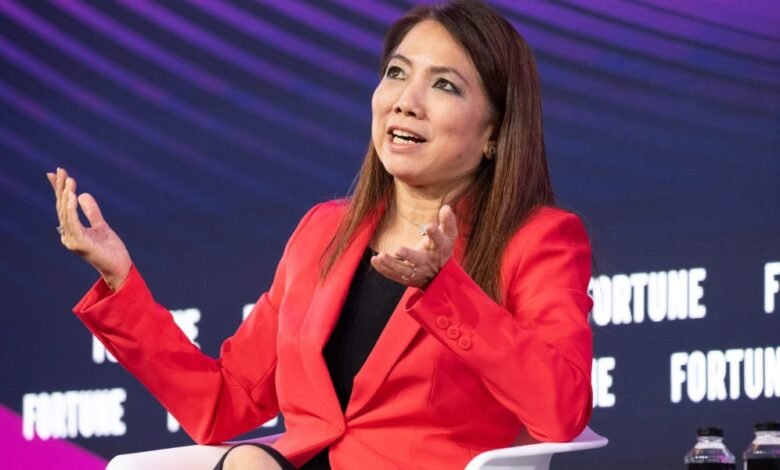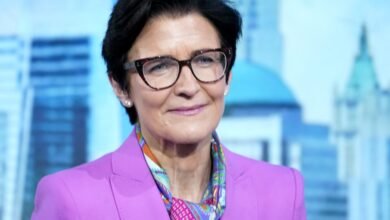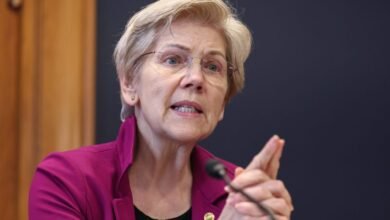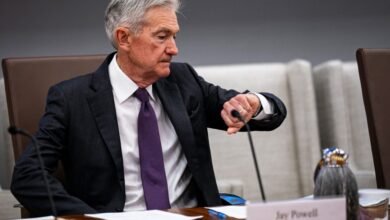

Good morning. “Even the CEO’s job can be replaced by AI.”
That was the WhatsApp message DBS Group’s board sent Tan Su Shan on the day they named her chief executive of Southeast Asia’s largest and most profitable bank. Tan shared the moment with me last week at Fortune’s Brainstorm AI Singapore conference — and her reaction landed like a challenge to the rest of the audience: “If the CEO can be replaced, so can everything else.”
That mix of excitement and existential threat ran through two days of debate among more than 70 leaders from nearly 20 countries.
Singapore’s digital minister Josephine Teo outlined her country’s AI strategy of carving a middle path between the U.S. and China, explaining how the city‑state of 6 million is shaping policy between Big Data superpowers. On another panel, executives from three of Asia’s most sophisticated data center operators debated Malaysia’s data center boom and the region’s prospects for satisfying the demand for energy. U.S. policy analysts also dissected the U.S.–China AI rivalry and Trump’s new AI action plan at the gathering. And digital artist Refik Anadol stunned the room with AI‑generated works that seemed equal parts data and dream.
Other panels tackled hard questions: Is AI wiping out entry‑level jobs? Can it adapt to local languages and cultures? Will it narrow global inequality — or widen it? Leaders from Google, Microsoft, OpenAI, Walmart, Accenture, Rakuten, Indeed, and others weighed in, often bluntly.
I left Singapore astonished by AI’s speed of change — and sobered by how much depends on leadership choices. Tan’s own advice to DBS employees, and perhaps to every executive navigating the shift, came down to four R’s: reinvent, stay relevant, be resilient, and act responsibly.
Contact CEO Daily via Diane Brady at diane.brady@fortune.com
Top news
Trump reaches deal with EU
President Donald Trump agreed to terms for a trade deal with the European Union that includes a 15% tariff rate on EU products besides pharmaceuticals and metals. The deal also includes $600 billion in investment in the U.S. from the EU and the purchase of $750 billion in U.S. energy. European stocks jumped on the news.
The deal doesn’t look great for Europe
Prior to the Trump administration, U.S. tariffs were 2.2% and the EU’s were 2.7%. It is still not clear whether the 15% level will apply to pharmaceuticals, one of the EU’s biggest exports. Trump previously threatened a 200% level for drugs. “I’m very surprised how the European Union gave in to Trump’s demands,” Douglas Irwin, a professor at Dartmouth, told the NYT. “I thought the E.U. would be the most prone to retaliation. And yet, they didn’t do it. They really gave in to most of what Trump wanted.”
Not ideal for the U.S., Canada, and Mexico, either
The EU deal creates wildly differing tariff levels for automakers, to the apparent advantage of those in Europe. “How can the administration square a 15 percent tariff on cars from Europe and Japan, while manufacturers in the U.S., Canada and Mexico are laboring under 25 percent tariffs?” said Patrick Anderson, CEO of the Anderson Economic Group.
Trump’s tariff deadline for everyone else is on Friday
The White House will not be moving the August 1 deadline, Commerce Secretary Howard Lutnick said.
Intel CEO announces layoffs
Intel CEO Lip-Bu Tan wrote a memo to employees last week announcing layoffs for about 15% of the company’s workforce and streamlining of some of the company’s operations. “There are no more blank checks,” Tan wrote.
New trend for CEOs: Being proud of layoffs and attrition
Investors like it when CEOs reduce costs and chief executives are responding by playing up headcount reductions. Bank of America’s Brian Moynihan, for instance, has reduced his workforce from 300,000 to 212,000. “We just got to keep working that down,” he said recently. Wells Fargo’s Charlie Scharf said that attrition was his “friend.” Loomis, Union Pacific, and Verizon have also touted job cuts.
Google’s earthquake warning system failed
About 70% of phones in Turkiye are Android yet almost none of them received an alarm during the 2023 earthquake that killed 50,000, according to an investigation by the BBC. Ten million people were in the radius of where the warning should have been targeted—giving people vital seconds to exit buildings. “We continue to improve the system based on what we learn in each earthquake”, a Google spokesperson said.
The markets
S&P 500 futures were up 0.31% this morning, premarket, after the index closed up 0.4% on Friday, hitting a new all-time high at 6,388.64. STOXX Europe 600 was up 0.67% in early trading. The U.K.’s FTSE 100 was up 0.14% in early trading. Japan’s Nikkei 225 was down 1.10%. China’s CSI 300 Index was up 0.21%. The South Korea KOSPI was up 0.42%. India’s Nifty 50 was down 0.6%. Bitcoin was flat at just under $119K.
From the analysts
ING on the US-EU trade deal: “The announcement of a US-EU trade deal has lifted equity futures on both sides of the Atlantic. Investors are more worried about a bubble now than a recession,” per Chris Turner and team.
Deutsche Bank on U.S. negotiations with China: “Meanwhile, US-China negotiations are underway in Stockholm today and tomorrow. Although their bespoke August 12th deadline looms, early reports — so far only from Chinese press headlines — suggest a 90-day extension has been granted. This development, if confirmed, would further reduce the urgency surrounding this week’s trade calendar. So expect the White House stationery cupboard to take a hit this week, with a flurry of letters flying out— but in the context of most of the big trade understandings having already been agreed,” per Jim Reid et al.
Goldman Sachs on the upcoming Fed meeting: “The most notable change since the June FOMC meeting is that the activity data have begun to show clearer signs of the below-potential growth that we and most forecasters have expected since it became clear in the spring that large tariff increases were coming. Concerningly, this deceleration has occurred before the drag from the trade war has likely peaked. While this has strengthened the case for rate cuts, the inflation and employment data and the range of views among FOMC participants have left the timing of the first cut an open question for now,” per Jan Hatzius et al.
Around the watercooler
Denny’s CEO asks potential hires these questions at the interview—if they can’t answer, it’s an immediate red flag by Preston Fore
Is a ‘pretty good’ Alexa+ good enough to pull off a comeback almost two years after Amazon’s revamped voice assistant was first announced? By Jason Del Rey
In his 20s, the boss of this 4,100-employee Fortune 500 company tried to refuse a promotion to CEO—his advice to new grads is stay ‘humble’ by Eleanor Pringle
CEO Daily is compiled and edited by Joey Abrams and Jim Edwards.
Source link




